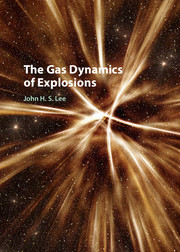Book contents
- Frontmatter
- Contents
- Preface
- 1 Basic Equations
- 2 Weak Shock Theory
- 3 Shock Propagation in a Non-uniform Cross-sectional Area Tube
- 4 Blast Wave Theory
- 5 Homentropic Explosions
- 6 The Snow-Plow Approximation
- 7 The Brinkley–Kirkwood Theory
- 8 Non-similar Solutions for Finite Strength Blast Waves
- 9 Implosions
- References
- Index
2 - Weak Shock Theory
Published online by Cambridge University Press: 05 June 2016
- Frontmatter
- Contents
- Preface
- 1 Basic Equations
- 2 Weak Shock Theory
- 3 Shock Propagation in a Non-uniform Cross-sectional Area Tube
- 4 Blast Wave Theory
- 5 Homentropic Explosions
- 6 The Snow-Plow Approximation
- 7 The Brinkley–Kirkwood Theory
- 8 Non-similar Solutions for Finite Strength Blast Waves
- 9 Implosions
- References
- Index
Summary
Introduction
The theoretical description of non-steady shock propagation is difficult in general as it involves the integration of the non-linear conservation equations. However, if the shock wave is weak, the entropy change across the shock is small and the shock can be treated as an isentropic compression wave. For a weak shock propagating into a uniform or quiescent medium, the flow behind it is a simple wave flow which can be determined by initial or boundary conditions. The shock motion can then be obtained by fitting the shock to the known simple wave flow behind it. The weak shock theories described in this chapter are of this nature. In Chandrasekhar's (1943) method, the characteristic equation is first transformed into the kinematic wave equation which has a particular solution corresponding to a linear distribution of flow variables behind the shock. The decay of the shock is then obtained by fitting the shock to the solution of the flow behind it. In the method of Friedrichs (1948), a simple wave flow is assumed behind the shock. The shock motion is then determined by matching the shock strength to give the same state as that carried by the characteristic that intersects it. The weak shock theory of Whitham (1956) is also very similar in nature to that of Freidrichs' method, except Whitham used a modified acoustic solution for the flow behind the shock. By modified acoustic theory, the linear acoustic solution is “non-linearized” by replacing the acoustic trajectories by the characteristics. In so doing, the distortion of the wave front can now be realized, whereas linear acoustic theory would give a wave front of permanent form. Oswatitsch (1956) also gave a theory for weak shock propagation. He assumed, as in Chandrasekhar's solution, a linear profile behind the shock and obtained a perturbation solution of the flow equations in the neighborhood of the sonic point (u = 0, c = c0) of the triangular shock profile. Since the profile is linear, the solution at the sonic point can be extended to the shock front. The shock strength is then matched to the solution behind it. The principal approximations used in all these weak shock theories are essentially similar. The difference lies in the description of the flow behind it and the method used to match the shock to the flow.
- Type
- Chapter
- Information
- The Gas Dynamics of Explosions , pp. 31 - 55Publisher: Cambridge University PressPrint publication year: 2016



